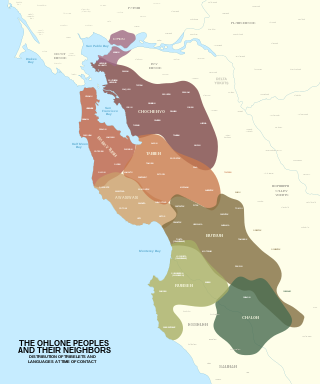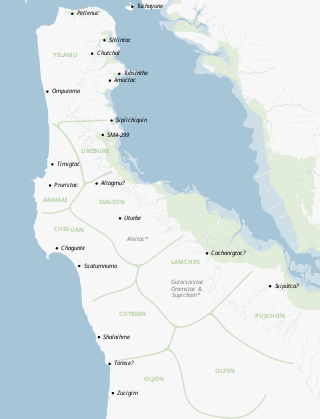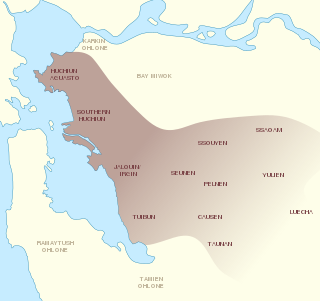Related Research Articles

The Ohlone, formerly known as Costanoans, are a Native American people of the Northern California coast. When Spanish explorers and missionaries arrived in the late 18th century, the Ohlone inhabited the area along the coast from San Francisco Bay through Monterey Bay to the lower Salinas Valley. At that time they spoke a variety of related languages. The Ohlone languages make up a sub-family of the Utian language family. Older proposals place Utian within the Penutian language phylum, while newer proposals group it as Yok-Utian.
The Bay Miwok are a cultural and linguistic group of Miwok, a Native American people in Northern California who live in Contra Costa County. They joined the Franciscan mission system during the early nineteenth century, suffered a devastating population decline, and lost their language as they intermarried with other native California ethnic groups and learned the Spanish language.

The Ramaytush or Rammay-tuš people are a linguistic subdivision of the Ohlone people of Northern California. The term Ramaytush was first applied to them in the 1970s, but the modern Ohlone people of the peninsula have claimed it as their ethnonym. The ancestors of the Ramaytush Ohlone people have lived on the peninsula—specifically in the area known as San Francisco and San Mateo county—for thousands of years. Prior to the California Genocide, the Ohlone people were not consciously united as a singular socio-political entity. In the early twentieth century anthropologists and linguists began to refer to the Ramaytush Ohlone as San FranciscoCostanoans—the people who spoke a common dialect or language within the Costanoan branch of the Utian family. Anthropologists and linguists similarly called the Tamyen people Santa Clara Costanoans, and the Awaswas people Santa Cruz Costanoans.

The Karkin language is an extinct Ohlone language. It was formerly spoken in north central California, but by the 1950s there were no more native speakers. The language was historically spoken by the Karkin people, who lived in the Carquinez Strait region in the northeast portion of the San Francisco Bay estuary. The name 'Karkin' means 'trader' in some varieties of Ohlone.
The mythology of the Ohlone (Costanoan) Native American people of Northern California include creation myths as well as other ancient narratives that contain elements of their spiritual and philosophical belief systems, and their conception of the world order. Their myths describe supernatural anthropomorphic beings with the names of regional birds and animals, notably the eagle, the Coyote who is humanity's ancestor and a trickster spirit, and a hummingbird.

The Tamien people are one of eight linguistic divisions of the Ohlone (Costanoan) people groups of Native Americans who live in Northern California. The Tamien traditionally lived throughout the Santa Clara Valley. The use of the name Tamien is on record as early as 1777; it comes from the Ohlone name for the location of the first Mission Santa Clara on the Guadalupe River. Father Pena mentioned in a letter to Junipero Serra that the area around the mission was called Thamien by the native people. The missionary fathers erected the mission on January 17, 1777, at the native village of So-co-is-u-ka.

The Chochenyo are one of the divisions of the Indigenous Ohlone (Costanoan) people of Northern California. The Chochenyo reside on the east side of the San Francisco Bay, primarily in what is now Alameda County, and also Contra Costa County, from the Berkeley Hills inland to the western Diablo Range.

The Ohlone languages, also known as Costanoan, form a small Indigenous language family historically spoken in Northern California, both in the southern San Francisco Bay Area and northern Monterey Bay area, by the Ohlone people. Along with the Miwok languages, they are members of the Utian language family. The most recent work suggests that Ohlone, Miwok, and Yokuts are branches of a Yok-Utian language family.

Indigenous peoples of California, commonly known as Indigenous Californians or Native Californians, are a diverse group of nations and peoples that are indigenous to the geographic area within the current boundaries of California before and after European colonization. There are currently 109 federally recognized tribes in the state and over forty self-identified tribes or tribal bands that have applied for federal recognition. California has the second-largest Native American population in the United States.

The Tamyen language is one of eight Ohlone languages, once spoken by Tamien people in Northern California.
The Ramaytush language is one of the eight Ohlone languages, historically spoken by the Ramaytush people who were indigenous to California. Historically, the Ramaytush inhabited the San Francisco Peninsula between San Francisco Bay and the Pacific Ocean in the area which is now San Francisco and San Mateo Counties. Ramaytush is a dialect or language within the Ohlone branch of the Utian family. The term Ramaytush was first applied to it during the 1970s, and is derived from the term rammay-tuš "people from the west". It is extinct, but efforts are being taken to revive it.
The Karkin people are one of eight Ohlone peoples, indigenous peoples of California.

Chochenyo is the spoken language of the Chochenyo people. Chochenyo is one of the Ohlone languages in the Utian family.

Vincent Medina is an Indigenous rights, Indigenous language, and food activist from California. He co-founded Cafe Ohlone, an Ohlone restaurant in Berkeley, California which serves Indigenous cuisine made with Native ingredients sourced from the San Francisco and Monterey Bay Areas. As of 2019 he was serving on the Muwekma council, and he is Capitán, or cultural leader, of the ‘Itmay Cultural Association.

Corrina Gould is a spokeswoman and Tribal Chair of the Confederated Villages of Lisjan/Ohlone, a non-profit organization. She identifies as a Chochenyo and a Karkin Ohlone woman and is a long-time activist who works to protect, preserve, and reclaim ancestral lands of the Ohlone peoples. The Ohlone people live in the greater San Francisco Bay Area, and Gould's organization, specifically, is located in the East Bay, in regions now occupied by Oakland, Berkeley, and beyond.
Johnella LaRose is an American grassroots organizer based in the San Francisco Bay Area who advocates for Indigenous communities and the preservation and restitution of Indigenous lands. LaRose identifies with the Shoshone Bannock and the unrecognized Carrizo tribe. Alongside fellow Indigenous rights' activist Corrina Gould, LaRose is a co-founder of Indian People Organizing for Change (IPOC), a San Francisco Bay Area-based organization working to protect and raise awareness about the region’s sacred shellmounds, and the Sogorea Te Land Trust, an urban land trust working to restore Indigenous stewardship of occupied Chochenyo and Karkin Ohlone lands in the East Bay Area.
The West Berkeley Shellmound, in West Berkeley, California, sits at the site of the earliest known habitation in the San Francisco Bay Area, a village of the Ohlone people on the banks of Strawberry Creek. The shellmound, or midden, was used for both burials and ceremonial purposes, and was a repository for shells, ritual objects, and ceremonial items. It is listed as a Berkeley Landmark. Part of the site was paved in the twentieth century and for many years was a restaurant parking lot. In the 21st century, the lot was acquired by a developer, but development plans were stalled by the City of Berkeley and local Native American activists. In 2024 an agreement was reached for the land to be returned to the Ohlone, facilitated by a gift to the Sogorea Te' Land Trust, which will pay the majority of the acquisition cost, with the city paying the remainder. An artificial mound covered with vegetation and housing an educational and memorial center is planned.
The Tongva Taraxat Paxaavxa Conservancy is an Indigenous urban land trust that formed with the objective to return or rematriate land to self-identified Tongva descendants in the greater Los Angeles County area. It was inspired by the work of the Sogorea Te’ Land Trust and has been associated with the Land Back movement. The conservancy is notable for its part in the return of Tongva land in Los Angeles County for the first time in nearly 200 years. The trust developed a kuuy nahwá’a or "guest exchange" program for people who live and work in the tribe's traditional homelands to financially support the land trust's goals.
Cafe Ohlone, also called ‘oṭṭoy, is a restaurant in Berkeley, California at the Phoebe A. Hearst Museum of Anthropology. It was founded by Ohlone chefs Louis Trevino and Vincent Medina as a pop-up in 2018, and as a semi-permanent café in 2022. It features a seasonal menu of California Indian cuisine and is the world's only Ohlone restaurant.
References
- 1 2 3 4 5 6 7 Kost, Ryan (November 28, 2017). "Indigenous women lead effort to reclaim ancestral lands". San Francisco Chronicle. Retrieved October 30, 2018.
- ↑ Golden, Kate (December 13, 2022). "How Indigenous People Got Some Land Back in Oakland". Bay Nature. Retrieved January 4, 2023.
- ↑ Stanger, Frank M., ed. 1968. La Peninsula Vol. XIV No. 4, March 1968.
- 1 2 3 4 5 6 7 8 9 10 NoiseCat, Julian Brave (March 22, 2018). "'It's About Taking Back What's Ours': Native Women Reclaim Land, Plot By Plot". Huffington Post. Retrieved October 30, 2018.
- 1 2 3 4 Parrish, Will (March 4, 2015). "Protecting Ohlone Heritage". East Bay Express. Retrieved October 30, 2018.
- 1 2 Rauch, Kate Darby (April 20, 2022). "'This land is coming back to us': Berkeley community garden gifted to Ohlone land trust". Berkeleyside. Retrieved June 30, 2022.
- 1 2 Dalmas, Jeremy (April 16, 2018). "Native Americans ask East Bay residents to pay 'tax' on land". KALW Local Public Radio 91.7 San Francisco. Retrieved October 30, 2018.
- ↑ "Shuumi Land Tax". Sogorea Te Land Trust. Retrieved October 30, 2018.